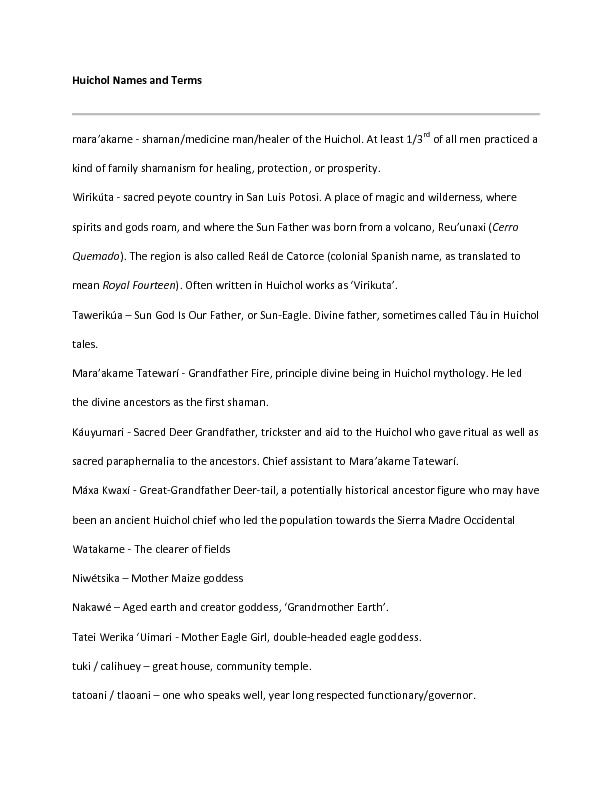Symbolic Glossary
Dublin Core
Title
Symbolic Glossary
Subject
huichol symbolism
Creator
Emmett Nahil, 2017
Source
Benítez, Fernando. In the Magic Land of Peyote. University of Texas Press, Austin. 1975.
Publisher
University of Pennsylvania Museum of Archaeology and Anthropology
Date
July 2017
Format
.pdf
Language
English, Spanish, Huichol
Type
Text
Text Item Type Metadata
Text
Huichol Names and Terms
mara’akame - shaman/medicine man/healer of the Huichol. At least 1/3rd of all men practiced a kind of family shamanism for healing, protection, or prosperity.
Wirikúta - sacred peyote country in San Luis Potosi. A place of magic and wilderness, where spirits and gods roam, and where the Sun Father was born from a volcano, Reu’unaxi (Cerro Quemado). The region is also called Reál de Catorce (colonial Spanish name, as translated to mean Royal Fourteen). Often written in Huichol works as ‘Virikuta’.
Tawerikúa – Sun God Is Our Father, or Sun-Eagle. Divine father, sometimes called Táu in Huichol tales.
Mara’akame Tatewarí - Grandfather Fire, principle divine being in Huichol mythology. He led the divine ancestors as the first shaman.
Káuyumari - Sacred Deer Grandfather, trickster and aid to the Huichol who gave ritual as well as sacred paraphernalia to the ancestors. Chief assistant to Mara’akame Tatewarí.
Máxa Kwaxí - Great-Grandfather Deer-tail, a potentially historical ancestor figure who may have been an ancient Huichol chief who led the population towards the Sierra Madre Occidental
Watakame - The clearer of fields
Niwétsika – Mother Maize goddess
Nakawé – Aged earth and creator goddess, ‘Grandmother Earth’.
Tatei Werika ‘Uimari - Mother Eagle Girl, double-headed eagle goddess.
tuki / calihuey – great house, community temple.
tatoani / tlaoani – one who speaks well, year long respected functionary/governor.
híkuri – Huichol word for peyote, used infrequently.
Nieríka – Splint to hold the world up, 4-directional prayer object (often called an ‘eye of god’ or ‘spirit eye’)
‘Utuanáka – Mother Earth Moistened by Rain and Ready for Planting
General Terminology
Deer: white= daylight dark= nighttime red= noontime, each color is symbolic. Deer and sets of antlers also can generally symbolize spirituality and the power of shamanic ritual in humanity.
Ancestor: aged spirit of deceased family members or kin groups, significant through blood relation or social proximity. Often with the ability to influence current events, harvest, or material affairs of the living.
Sun: Planetary body, also affiliated with Tawerikúa.
Peyote: A small, spineless cactus with psychoactive alkaloids, particularly mescaline. The anglicized name derives from the Nahuatl name peyōtl, and has been used by indigenous groups in Central and North America in ritual and spiritual visions for centuries.
Snake: Represents rain spirits,
Butterfly:
Grandfather Sun:
Grandfather Fire: Led the divine ancestors as the first shaman.
Great-grandmother Earth: Original creator goddess, made all directions of the earth, as well as the center of the world, as represented by the nieríka.
5 Rain Goddesses: One goddess for each direction and one for the cosmic center, appear as snakes in art. They were the first creatures created by Grandmother Earth.
mara’akame - shaman/medicine man/healer of the Huichol. At least 1/3rd of all men practiced a kind of family shamanism for healing, protection, or prosperity.
Wirikúta - sacred peyote country in San Luis Potosi. A place of magic and wilderness, where spirits and gods roam, and where the Sun Father was born from a volcano, Reu’unaxi (Cerro Quemado). The region is also called Reál de Catorce (colonial Spanish name, as translated to mean Royal Fourteen). Often written in Huichol works as ‘Virikuta’.
Tawerikúa – Sun God Is Our Father, or Sun-Eagle. Divine father, sometimes called Táu in Huichol tales.
Mara’akame Tatewarí - Grandfather Fire, principle divine being in Huichol mythology. He led the divine ancestors as the first shaman.
Káuyumari - Sacred Deer Grandfather, trickster and aid to the Huichol who gave ritual as well as sacred paraphernalia to the ancestors. Chief assistant to Mara’akame Tatewarí.
Máxa Kwaxí - Great-Grandfather Deer-tail, a potentially historical ancestor figure who may have been an ancient Huichol chief who led the population towards the Sierra Madre Occidental
Watakame - The clearer of fields
Niwétsika – Mother Maize goddess
Nakawé – Aged earth and creator goddess, ‘Grandmother Earth’.
Tatei Werika ‘Uimari - Mother Eagle Girl, double-headed eagle goddess.
tuki / calihuey – great house, community temple.
tatoani / tlaoani – one who speaks well, year long respected functionary/governor.
híkuri – Huichol word for peyote, used infrequently.
Nieríka – Splint to hold the world up, 4-directional prayer object (often called an ‘eye of god’ or ‘spirit eye’)
‘Utuanáka – Mother Earth Moistened by Rain and Ready for Planting
General Terminology
Deer: white= daylight dark= nighttime red= noontime, each color is symbolic. Deer and sets of antlers also can generally symbolize spirituality and the power of shamanic ritual in humanity.
Ancestor: aged spirit of deceased family members or kin groups, significant through blood relation or social proximity. Often with the ability to influence current events, harvest, or material affairs of the living.
Sun: Planetary body, also affiliated with Tawerikúa.
Peyote: A small, spineless cactus with psychoactive alkaloids, particularly mescaline. The anglicized name derives from the Nahuatl name peyōtl, and has been used by indigenous groups in Central and North America in ritual and spiritual visions for centuries.
Snake: Represents rain spirits,
Butterfly:
Grandfather Sun:
Grandfather Fire: Led the divine ancestors as the first shaman.
Great-grandmother Earth: Original creator goddess, made all directions of the earth, as well as the center of the world, as represented by the nieríka.
5 Rain Goddesses: One goddess for each direction and one for the cosmic center, appear as snakes in art. They were the first creatures created by Grandmother Earth.
Original Format
.pdf
Collection
Citation
Emmett Nahil, 2017, “Symbolic Glossary,” Spanish Language at the Penn Museum, accessed September 18, 2024, https://pennds.org/spanishatpennmuseum/items/show/20.
